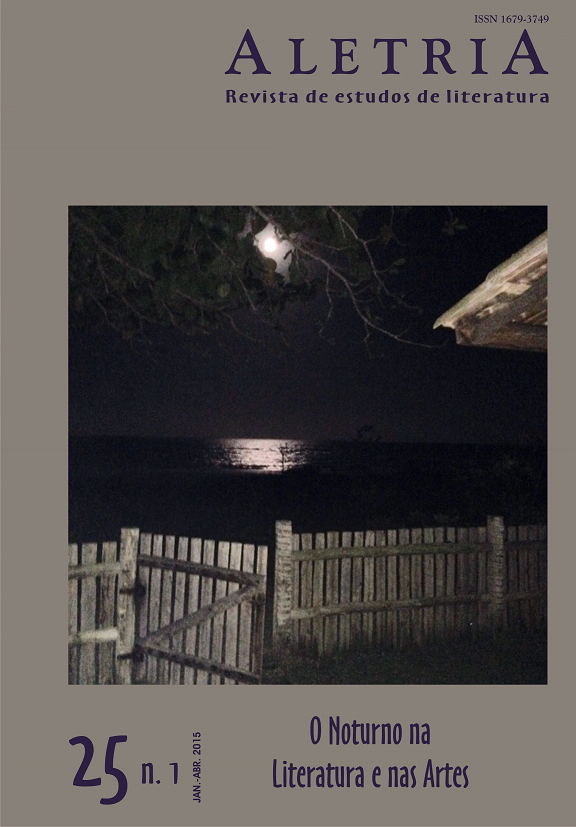Nightly Landscapes: Fiction, Legend and History in the Backcountry Narratives of Coelho Neto
DOI:
https://doi.org/10.17851/2317-2096.25.1.27-49Keywords:
Coelho Neto, landscape, Brazilian literary regionalism, Brazilian national identity, supernaturalAbstract
This article analyses the backcountry fiction of Coelho Neto. It aims at identifying the formation of the thematic and aesthetic conventions of Brazilian regionalist literature through his prose’s nightly images. The study considers that such images are conveyed throughout the writer’s fictional production via landscape descriptions and supernatural narratives. The former is an essential dimension of his production since it defines a clear sensibility towards nature evoking sensory memories of the physical environment. On the other hand, the latter incorporates fundamental themes of his rural fiction - sexuality; economic exploitation of the territory and miscegenation – examining Brazil’s formation through images of colonization and slavery. In conclusion, the writer merged imagination and history and created a unique representation of the itinerary of Brazilian society over time.
Downloads
References
BAGULEY, David. Le naturalisme et ses genres. Paris: Nathan, 1995.
BENJAMIN, Walter. O narrador – Considerações sobre a obra de Nikolai Leskov. In: BENJAMIN, Walter. Magia e técnica, arte e política. Ensaios sobre literatura e história da cultura. Obras escolhidas. v. 1. 8. ed. Tradução Sérgio Paulo Rouanet. São Paulo: Brasiliense, 2012. p. 213-240.
BERQUE, Augustin. La pensée paysagère. Paris: Archibooks, 2008.
CANDIDO, Antonio. Literatura e subdesenvolvimento. In: CANDIDO, Antonio. A educação pela noite & outros ensaios. São Paulo: Ática, 1989. p. 140-161.
COELHO NETTO. A conquista. 2. ed. Porto: Chardron, 1913. [1ª ed. 1899].
COELHO NETTO. Banzo. Porto: Lello & Irmão, 1912.
COELHO NETTO. Compendio de litteratura brasileira segundo o programma do Gymnasio Nacional. Rio de Janeiro: Francisco Alves, 1905.
COELHO NETTO. Miragem. 4. ed. Porto: Chardron, 1926. [1ª ed. 1895].
COELHO NETTO. Praga. Rio de Janeiro: J. Cunha, 1890.
COELHO NETTO. Rei Negro. Romance bárbaro. 2. ed. Porto: Chardron, 1926. [1ª ed. 1914].
COELHO NETTO. Sertão. Porto: Lello & Irmão, 1933. [1ª ed. 1896].
COELHO NETTO. Treva. 3. ed. Porto: Chardron, 1924. [1ª ed. 1905].
COELHO NETTO, Paulo. Coelho Netto. Rio de Janeiro: Valverde, 1942.
DURAND, Gilbert. As estruturas antropológicas do imaginário. Tradução Hélder Godinho. São Paulo: Martins Fontes, 2002.
GRIVEL, Charles. Fantastique-fiction. Paris: Presses Universitaires de France, 1992.
HALBWACHS, Maurice. La topographie légendaire des évangiles en Terre Sainte. Paris: Presses Universitaires de France, 2008.
HEUSSER, Calvin. Bogs. In: HARRISON, Stephan; PILE, Steve; THRIFT, Nigel. Patterned Grounds. Entanglements of Nature and Culture. Londres: Reaktion, 2004. p. 146-148.
HOLANDA, Sérgio Buarque de. Caminhos e Fronteiras. São Paulo: Companhia das Letras, 2001. p. 74-89.
ISER, Wolfgang. O fictício e o imaginário. Perspectivas de uma antropologia literária. Tradução Johannes Kretschmer. Rio de Janeiro: EdUERJ, 1996.
JAKOB, Michael. Le paysage. Gollion: Infolio, 2002.
JOURDE, Pierre. L’alcool du silence. Sur la décadence. Paris: Honoré Champion, 1994.
LIMA, Luís Costa. Sociedade e discurso ficcional. Rio de Janeiro: Guanabara, 1986.
MACNAGHTEN, Phil. Trees. In: HARRISON, Stephan, PILE, Steve, THRIFT, Nigel. Patterned Grounds. Entanglements of Nature and Culture. Londres: Reaktion, 2004. p. 232-234.
MURARI, Luciana. Uma geografia literária do Brasil. Ipótesi, Juiz de Fora, v. 18, n. 1, p. 35-50, jan.-jun. 2014.
MURARI, Luciana. Natureza e cultura no Brasil. 1870-1922. São Paulo: Alameda, 2009.
PAES, José Paulo. O art-nouveau na literatura brasileira. In: PAES, José Paulo. Gregos e baianos. São Paulo: Brasiliense, 1985. p. 64-80.
PAES, José Paulo. Canaã e o imaginário modernista. São Paulo: Edusp, 1992.
Downloads
Additional Files
Published
How to Cite
Issue
Section
License
Copyright (c) 2015 Luciana Murari (Autor)

This work is licensed under a Creative Commons Attribution 4.0 International License.
Authors who publish with this journal agree to the following terms:Authors retain copyright and grant the journal right of first publication with the work simultaneously licensed under a Creative Commons Attribution Non-Commercial No Derivatives License that allows others to share the work with an acknowledgement of the work's authorship and initial publication in this journal.Authors are able to enter into separate, additional contractual arrangements for the non-exclusive distribution of the journal's published version of the work (e.g., post it to an institutional repository or publish it in a book), with an acknowledgement of its initial publication in this journal.Authors are permitted and encouraged to post their work online (e.g., in institutional repositories or on their website) prior to and during the submission process, as it can lead to productive exchanges, as well as earlier and greater citation of published work (See The Effect of Open Access).





